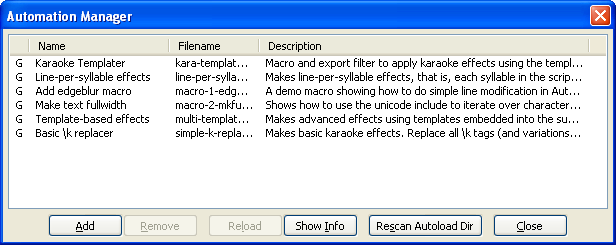Automation Manager
From Aegisub Manual
The Automation Manager window is used to view, load and unload Automation scripts.
The Automation Manager window is opened from the Automation menu or with the ![]() toolbar button.
toolbar button.

[edit] The script list
The main area of the window is a list of all script files loaded. It's important to remember that one script file can contain several features, for example one script file can define two macros and one export filter.
Scripts can be loaded in one of two ways. In the screenshot above, all the scripts are global (autoloaded), this can be seen from the "G" in the leftmost column. Global scripts are automatically loaded along with Aegisub. They are put in one of the Automation autoload folders. You can not unload global scripts, you can however remove them from the autoload folder.
The other type of scripts are local scripts, these are scripts loaded by you. Each subtitle file has a list of local scripts stored in it, when you save your subtitle file the list of loaded scripts is stored along with it, and all the scripts are loaded when you then open that subtitle file again. Local scripts are shown with an "L" in the leftmost column.
Sometimes a script is shown in red in the list. This only happens if the script could not be loaded for some reason. The reason will usually be shown in the Description column. If the description of the error is too long to read, you can select the script and click the Show Info button to see it all. Scripts failing to load should only happen if you are writing your own scripts and manage to make a programming error.
[edit] The buttons
There are 6 buttons at the bottom of the Automation Manager window:
- The Add button is used to load a local script.
- The Remove button is used to unload a local script. It is only available when a local script is selected.
- The Reload button unloads and reloads the selected script file from disk. You can use this to reload scripts you're developing, but also see below for other ways to do this.
- The Show Info buttons shows detailed information on the selected script, as well as the entire Automation system.
- The Rescan Autoload Dir button scans the autoload folders to see if any scripts have been added or removed since Aegisub was started. All new scripts in the autoload folders are then loaded, scripts that have been removed are unloaded and all other global scripts are reloaded.
- The Close button closes the Automation Manager window.
[edit] Other ways to reload scripts
If you're developing scripts you might find yourself returning to the Automation Manager often to reload your script. There are also faster ways to reload scripts though:
- When the Export dialog is opened all local scripts are reloaded. You can change this in the Options dialog.
- Hold the Ctrl key and click the Automation toolbar button to rescan the autoload folders.
- Hold both the Ctrl and Shift keys and click the Automation toolbar button to reload all scripts, also rescanning the autoload folders.
The Automation Manager won't open when any of there methods are used, but you will get an error message window if a script failed to load.
[edit] For users of Aegisub 1.10 and earlier
You may wonder where several of the functions that were previously in the Automation Manager have gone.
- The Create and Edit buttons were removed since they never worked fully as intended. You're encouraged to instead use your favourite file manager or editor to find and open the scripts you want to edit. Creating new scripts is also a bit easier since the formal requirements for Automation 4 scripts are much looser than for Automation 3 scripts. Another otherwise commonly used method to create new scripts is just to copy an existing script and edit that instead; the Create button wouldn't be much help there either way.
- The Apply now button was removed for two reasons. The first and most important is that it doesn't fit into the Automation 4 design at all. In Automation 3 every script file only did one thing so it was obvious what it meant to "apply" it. This isn't the case with Automation 4, one script file can have several functions (features), so which of them should be applied? The other, and rather minor reason, is that burying the button inside a dialog is just not a good place, you will have to cancel out of the Automation Manager window to undo the effect of the script if you decided you weren't satisfied, just to immediately return to it, reload the script and Apply again. The Automation 4 solution to this is to create a macro instead. It's available directly from the Automation menu and you can easily reload using one of the methods listed above.
| Overview: |
Automation Manager • Running macros • Using export filters • Standard macros • Changes from Automation 3 • Moving from Automation 3 |
|---|---|
| Karaoke Templater reference: |
Declaring templates • Execution order • Modifiers • Inline-variables ($-variables) • Code lines and blocks • Execution envirionment |
| Lua reference: |
Registration • Subtitles object • Progress reporting • Config dialogues • Misc. APIs • karaskel.lua • utils.lua • unicode.lua • cleantags.lua |
| Karaskel concepts: |
Style tables • Dialogue line tables • Syllable tables • Inline effects • Furigana |